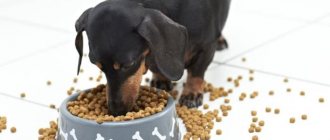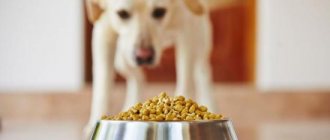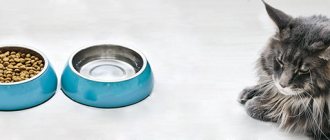Features of puppy development at 3 months
The developmental characteristics of a puppy at 3 months may vary slightly depending on the breed. However, almost all puppies between 3 and 6 months of age are in the active growth stage. A constantly growing body, the need for communication, activity and acquiring new skills creates increased energy needs.
A balanced diet is one of the key factors in the timely development of a puppy, both physically and mentally. At the age of 3 months, the pet’s body begins to prepare for the replacement of baby teeth, which leads to an increased need for vitamins and microelements. In addition, before the replacement of baby teeth, the puppy’s immune defense is sharply reduced . During the period of feeding with mother's milk, the puppy receives not only nutrition, but also antibodies that protect it until the age of three months.
At the age of 2 months or slightly older, your pet should be vaccinated. 2 weeks before vaccination it is necessary to carry out parasite prevention. Before preparing for vaccination, you must visit a veterinarian, since vaccinations can only be given to an absolutely healthy animal. If the doctor finds that the pet is suffering from any ailment, treatment is carried out first, and after vaccination.
Features and patterns of development of a puppy at 3 months
From the moment they are born, puppies go through certain developmental stages related to their growth, puberty and behavioral factors. The juvenile period, which begins at 12 weeks, has its own characteristics and requires especially careful attention to the diet.
Dogs, like no other from the world of mammals, have gigantic intraspecific differences: breed individuals differ in weight, size, they have different types of fur and heat transfer, and also differ in natural “functionality”: some perform hard physical work, others spend their entire lives on sofa Also, puppies of different breeds have a genetic predisposition to food components.
Depending on these factors, the diets of 3-month-old puppies may differ, and you should ask the breeder about the nuances of feeding or study special literature.
However, there are also general patterns in the development of puppies at 3 months, which leave an imprint on the preparation of the menu:
- It's time to change teeth.
- The breed's anatomical features and exterior features that require support from nutrients (ear placement, correct angles of the limbs, coat quality, back line, etc.) are clearly visible.
- The puppy is rapidly developing, both externally and in terms of the formation of internal organs and the nervous system.
- Puppies at this age begin to walk: physical activity increases and the immune system also needs support.
Energy consumption at this age is extremely significant, and only a well-formulated diet that takes into account the needs of the puppies’ growing body for high-calorie food can compensate for them. The lack of important nutrients affects the underdevelopment of organs and systems, the dog’s poor health and its appearance.
In all types of nutrition, regardless of breed characteristics or functional qualities, the basis of the diet should be meat ingredients.
Dry food for a puppy at 3 months
Most owners prefer to feed their pet dry food because it is convenient and saves time. However, at three months of age, a puppy is not ready to eat dry granules and there are a number of good reasons for this. The puppy's digestive tract adapts to digesting new food gradually. Dry granules entering the digestive tract actively absorb water. At such a young age, feeding dry food can lead to dehydration, even with active drinking of water.
Dry food can be introduced into a puppy’s diet only in a soaked form. To prevent the granules from harming the pet’s body, they must be filled with warm water or broth 10–15 minutes before feeding. After the granules are saturated with water, increase in volume and become soft, they must be crushed and mixed with canned food. For large breed puppies, soaked dry food can be introduced into the diet from 3 months, for others not earlier than 4 months.
Puppy diet at 3 months
At three months, the need for milk decreases significantly, so the puppy’s diet is based on meat as the main source of protein, as well as cereals and vegetables that provide carbohydrates and fiber. Milk is replaced with fermented milk products, which are easier to digest. Also, a properly formed diet must include fats and vitamin and mineral supplements.
Meat and animal products
It is best to choose lean beef from meat; it can be given raw or boiled. Raw meat contains more vitamins, so it is recommended to include it in your daily diet, at least 20% of the total amount. It is important to remember that raw meat may contain bacteria and worm eggs, so you should use a frozen product. The meat is given finely chopped; it is not recommended to use minced meat - it forms lumps in the stomach, so it is not completely digested.
At three months, meat becomes the basis of a German Shepherd puppy’s diet.
You can also give boiled chicken meat, rabbit meat, and add soft cartilage to the porridge. Fatty meats are poorly digestible and can cause indigestion. Eggs are given separately - the raw yolk can be added to porridge, the white must be boiled and cut. It is convenient to feed eggs like an omelet with milk.
It is recommended to add meat broths to the menu - substances boiled from bones are very useful for the proper development of the animal's skeleton, and also help to improve the functioning of the gastrointestinal tract. This broth needs to be simmered over low heat for at least four hours; the prepared liquid can also be used to add to porridge instead of milk.
IMPORTANT: You can give large beef bones that the dog cannot yet chew, but small chicken bones should be avoided. The puppy can injure the mucous membranes of the mouth and gastrointestinal tract with sharp fragments.
At three months of age, only large beef bones can be given
Cereals and vegetables
Porridges are rich in easily digestible carbohydrates and are high in calories. They are cooked from various types of cereals - buckwheat, rice, millet, rolled oats, semolina. You can cook it either in water or in a solution of whole milk. Puppies do not eat pearl barley and barley very readily, so they are used in a mixture with others.
Vegetables are a source of vitamins, organic acids, starch, mineral salts and phytoncides. Vegetables are given to puppies in raw and boiled form - beets, tomatoes, zucchini, cabbage, cucumbers and others. Potatoes are given only raw as a delicacy. It is recommended to chop the carrots and mix with a spoon of vegetable or olive oil. Puppies are also given apples and berries - it is best to add them to cottage cheese.
At 3 months old, a German Shepherd puppy needs four meals a day.
Dairy products
Milk and products made from it are sources of protein and calcium and partially replace meat. The amount of milk for a three-month-old puppy is usually reduced, but you can leave it in the diet for up to six months. The puppies' diet includes low-fat kefir and cottage cheese; they also give yogurt, plain yogurt, and fermented baked milk. High fat dairy products should be avoided. Also, too much cottage cheese (more than 100g) can lead to constipation.
Vitamins and minerals
To replenish the daily requirement of vitamins, the dog should eat fresh greens - parsley, green onions, lettuce, spinach, beet and carrot tops, scalded nettles. It is useful to give puppies sprouted oats and millet, which contain many useful microelements. Sprouted grain is given either fresh or dried and ground, no more than 1 tablespoon per day. It is also recommended to add mineral supplements - meat and bone meal, crushed shells. Pharmacy edible sulfur is given for wool, and yeast is given for digestion and appetite.
IMPORTANT: It is also recommended for puppies to add ready-made vitamin complexes - tablets or granules - to their diet. You should consult your veterinarian first—an excess of certain vitamins and minerals can lead to serious negative health consequences.
Vitamins are included in a puppy’s diet only on the recommendation of a veterinarian.
Bread
It is very convenient to give bread along with kefir and milk. It also provides your pet with carbohydrates and fiber and causes an increase in the production of gastrointestinal enzymes. You should choose rye or gray wheat varieties; stale bread is preferable to fresh bread. It is best to dry rye bread and give it in the form of crackers. You can also add crackers to the meat broth.
If there is an excess of bread (more than 100-150 g), the puppy may experience increased gas formation and constipation.
Canned food
Commercial canned dog food comes in the form of pates and kibbles with gravy. The pates are suitable for feeding a puppy aged 1 to 2 months. Afterwards, the pet can be transferred to canned food so that it learns to chew and consume food similar to porridge.
While feeding canned food, it is important not to forget that the basis of the diet should be milk. If you are following a commercial diet, your puppy can only be given a bitch milk replacer, which is sold in powder form and diluted with water. To prevent your puppy from developing dehydration, you need to make sure that he drinks enough water.
The key factor when choosing a canned commercial food for your puppy is quality. Traditionally, feed is divided into four classes. For daily feeding of puppies, premium food and higher are suitable. Economy class food does not contain enough proteins, vitamins, but contains preservatives, flavor enhancers and useless fillers.
Natural food for a three month old puppy
Natural food is considered more natural for feeding dogs. At three months of age, a puppy is able to digest almost the entire range of natural products approved for feeding dogs.
The diet should be based on protein foods:
- Milk, homemade fermented milk products, including cottage cheese.
- Boiled meat or after long-term freezing - beef, veal, rabbit, chicken, turkey; if you are not overweight, you can use duck.
- Meat by-products, cleaned and boiled – heart, lungs, udder, beef liver. You can use ground beef tripe raw.
- Chicken and quail eggs, boiled and raw.
- Sources of carbohydrates are rice, buckwheat, barley flour. If you are underweight and have no allergies, you can have wheat cereal. If you are at risk of gaining excess weight, you can use pearl barley.
- Sources of hard fibers are carrots, cucumbers, zucchini, pumpkin, boiled cabbage, raw potatoes, etc.
- Sources of vitamins are not too sweet and juicy fruits and greens.
At three months of age, you can prepare porridge for the puppy or give food separately. To prepare complex meals, you can use simple recipes. For example, you can make an omelet from eggs and milk, which is fried in a dry frying pan. By mixing cottage cheese and carrots, you will get food for your pet rich in calcium, proteins and vitamins.
Mixed feeding - what is it?
Some owners prefer mixed feeding, that is, keeping the pet simultaneously on industrial and natural food.
Feed manufacturers and veterinarians do not recommend this type of feeding, although the experience of many owners suggests otherwise.
From a theoretical point of view, the dog's gastrointestinal tract is not able to adapt to the digestion of natural and industrial products that the dog consumes at the same time.
It is important to understand that natural food enters the intestines and begins to be digested 10–20 minutes after eating. Dry food needs 20–40 minutes to gain moisture and drop into the intestines. It turns out that when feeding dry granules and natural products at the same time, some of the food is simply not digested. This problem can be solved by pre-soaking the dry food.
Weight and height of puppies
Below are standard development indicators for Golden Retriever puppies by month. These parameters are average - cuties can grow and gain weight more slowly or faster, depending on their genetic predisposition.
The main thing is that the baby feels good: eats with appetite, plays cheerfully, sleeps well. There is no point in overfeeding a puppy in order to raise a larger dog - retrievers are prone to obesity.
| Age (months): | Weight, kg): | Height (cm) at withers: |
| 1 | 3,4-3,8 | 23-24 |
| 2 | 7-8 | 30-32 |
| 3 | 12-14 | 39-42 |
| 4 | 17-19 | 44-46 |
| 5 | 20-22 | 48-51 |
| 6 | 24-26 | 50-55 |
| 7 | 26-28 | 52-56 |
| 8 | 28-30 | 54-57 |
| 9 | 29-32 | 53-58 |
| 10 | 30-36 | 54-58 |
| 11-12 | 30-38 | 55-61 |
Parameters of adult dogs:
- Boys: height at withers – 56-61 cm.
- Girls: height at withers – 51-56 cm.
The parameters of the animal also depend on its “career”: retrievers participating in exhibitions are more well-fed, rounded, and “working” dogs are fit and lean.
Feeding regimen for a puppy at 3 months
At three months of age, the puppy receives its first vaccination, after which it can be walked outside. For many owners, this event becomes a holiday, since the pet can be trained to use the toilet outside the home. Feeding schedule is extremely important at three months of age, as you will be able to track caloric intake and the time after which the pet needs to be taken outside.
The frequency of feeding a puppy at 3 months of age is individual and ranges from 3 to 5 meals per day. The smaller the dog, the more often it should eat. Intentionally increasing the portion of food when the puppy is not ready for this leads to overdistension of the stomach, which can lead to overeating and excess weight gain in the future.
How to determine the daily norm?
Before feeding a 3-month-old puppy dry food, you need to familiarize yourself with the recommendations for the amount of food per day, which are contained on the packaging of each product in the form of tables. We will show you how to correctly interpret the data given in them using the example of a diet for large breed puppies from the Acana brand range.
In order to find out how much dry food to give, you need to know the actual weight of your puppy, as they say, here and now, so don’t be lazy to weigh your pet. The easiest way to do this is to take the baby in your arms and stand with him on the bathroom scale. Then just weigh yourself separately and subtract the smaller number from the larger number.
Another important indicator you will need is the puppy's future weight as an adult. If this is a purebred dog, then the future size of the dog can be found on any breed website, and if your puppy is a nobleman, then your veterinarian will tell you his expected height and weight. So, we combine the current weight of the puppy with the weight of the adult dog, and we get the desired figure in grams. For example, if a puppy weighs 10 kg and will weigh 50, then he needs 300 g of dry food per day.
It is even easier to determine the norm for food intended for feeding both puppies and adult dogs. Look at the table with recommendations for feeding one of the Orijen brand diets - with six types of fish.
To determine the daily requirement, you need to know the current weight of the puppy and find the corresponding figure in the “Increased activity” column, and then simply multiply the found figure by two. Thus, if your puppy weighs 5 kg at three months, then double the norm of 90 g will equal 180 g - this is how much food the puppy should receive per day.
Water in a puppy's diet at 3 months
Water is the basis of blood and all body fluids. With a lack of water, the blood in puppies thickens, which leads to harmful consequences. In puppies at three months of age, dehydration develops rapidly and can cause irreparable harm.
Important! Dehydration is one of the key reasons why it is not recommended to feed dry food pellets to puppies at three months of age.
Typically, puppies do not have problems drinking water if a drinking bowl is readily available. When choosing a commercial diet, make sure that your pet has at least two large drinking bowls freely available to him. The water needs to be changed once a day, more often in hot weather. The higher the air temperature, the faster pathogenic microflora develops in the water, and this is fraught with indigestion and disruption of the gastrointestinal tract.
How many times should I feed?
This is a debatable issue, and although the general rule we mentioned above remains unchanged, the number of meals depends on the individual characteristics of the puppy. Some breeders recommend feeding a three-month-old baby 5-6 times a day, but this applies more to natural food, which is much larger in volume than dry food.
If you have chosen a ready-made industrial diet for your pet, then since this is concentrated food, the number of feedings can be reduced to four. Thus, the daily intake of dry food should be divided into four meals.
Vitamins and supplements
Until the puppy leaves the active growth phase, he constantly needs vitamins and supplements with microelements. If you keep your pet on a commercial diet, its needs for vitamins and minerals can be compensated with the help of high-quality food of super premium class or higher. When feeding premium food or a natural diet, vitamin supplements must be added to the puppy’s diet.











